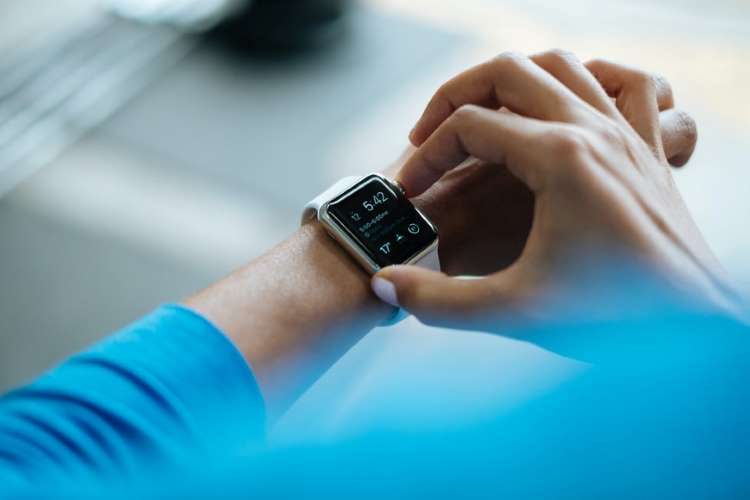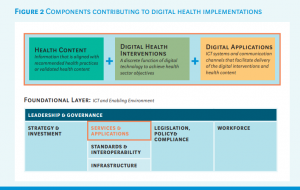
There is an exponential growth in the number of digital health apps available on Google Play and App Store. It is estimated that there were 53,054 Android apps and 53,979 iOS apps available in the beginning of last year (L. Ceci). Innovation in the digital health domain is taking place at an unprecedented scale. Studies found that about 25% of the adults aged between 18 and 34 years were using at least one health app.
Digital health is an umbrella term that discusses a range of information technologies that can collect health-related data and share health information. This includes mobile health applications (apps), electronic health records, telehealth, telemedicine, wearable devices, robotics and artificial intelligence.
Digital apps are expected to provide a new approach to the health and wellbeing of the users. Apps are supposed to help users and sponsors to take proactive action on individual and public health. Apps encourage users to access widely accepted health and medical facts to help them understand more about their conditions. This may help them engage in more productive discussions with healthcare providers. Health and medical apps also help collect more systematic data on health and wellness conditions.

READ I Public health: Profit motive, state inaction dictate outcomes
No set standards for digital health apps
Due to the lack of commonly agreed standards for validating apps before they are launched, there is a misplaced trust in the scope of digital health solutions. Unfortunately, some of the heavily promoted apps turn out to be a waste of resources with tremendous opportunity costs on the health and wellbeing of the society. As the health apps continue to grow in number and complexity, the ability for stakeholders in healthcare to discern quality lags far behind. This challenge is partly due to the lack of a transparent and standardised approach to validation.
A quick review of data and literature indicates that limited evidence exists on the commonly agreed evaluation framework to assess the efficacy of digital apps. Evaluation of mobile health applications is further burdened by low barriers to development and direct-to-user marketing, leading to a crowded and confusing landscape (Sedhom et al., 2021).
Henson and colleagues investigated the usability and efficacy of smartphone apps in mental health. Although smartphone apps can help people with depression, identifying quality, evidence-based apps remain a challenge (Henson et al., 2019). Furthermore, despite implementation in many countries, little empirical evidence exists about the effectiveness of digital tracing apps (Jenniskens et al., 2021). A substantial amount of research on contact tracing apps (CTA) for SARS CoV-2 has been conducted. However, methodologically sound comparative empirical studies on the effectiveness of CTAs are required to confirm findings from model-based studies. (Jenniskens et al. 2021).
READ I Universal health insurance a distant dream without healthcare reforms
The quality of mobile health apps that physicians and patients use varies markedly. Findings by Sedhom and colleagues demonstrated that popular oncology apps did not meet high-quality standards across multiple domains and end-user requirements. These broad deficiencies call into question whether widespread use of these solutions is appropriate or beneficial. There was significant variability in performance across individual domains and focus areas. That the apps evaluated were popular suggests that individual domain attributes may have attracted users instead of complete solutions or that users may not be aware of app quality metrics. (Sedhom 2021)
Australia is a digitally connected nation with most of its citizens using internet. As of January 2021, there are 22.82 million internet users in Australia. The number of active internet users may be reaching market saturation levels. Internet penetration rate in Australia grew from 87% in 2019 to 88% in 2020 and to 89% next year. (Gjorgievska 2021)
According to the Australian Digital Health Agency (ADHA), an estimated 98% of the Australian population will have a My Health Record. Australia will have the highest participation rate in a national health record system globally. Members of healthcare teams will have ready access to essential health information for their patients.
Almost three-quarters (73%) including the majority of older Australians have used the internet to research a health issue. Most Australians (77%) would like their doctor to suggest health information websites (ADHA 2017). However, only a small proportion (6%) of Australians find an online health source that they trust (ADHA 2017).
The Australian public accesses their health information from My Health Record through mobile apps. Several app developers are providing innovative mobile digital health apps that address the challenges faced by health consumers and healthcare providers. However, the lack of data on the effectiveness of digital Apps remains a concern.
COVIDSafe is a digital contact tracing App announced by the Australian government on April 14 2020 to help combat the Covid-19 pandemic. Florian Vogt and colleges carried out a study on the effectiveness of the digital contact tracing Apps for Covid-19 in New South Wales. They found that COVIDSafe did not make a meaningful contribution to the COVID response in NSW. Instead, the app created a high workload for no apparent benefit. It cost A$7.7 million to develop and run COVIDSafe until April 2021, and $60,000-$75,000 per month for maintenance since. (Florian Vogt, Bridget Haire, Linda Selvey, Anthea L Katelaris, John Kaldor, 2022)
The arrival of the fast-spreading Omicron variant in late 2021 coinciding with the lifting of most public health restrictions in Australia led to a massive expansion in case numbers, forcing a series of significant adjustments to contact tracing. Subsequently, Australia abandoned the COVIDSafe app.
Vogt and colleagues further explained the low uptake of app among cases probably led to a reduced sensitivity estimate in their study, given that only contacts who were using the app could be detected. As a result, COVIDSafe was not sufficiently effective to make a meaningful contribution to the Covid-19 response in Australia’s most populous state. The study provided an empirical evaluation of this digital contact tracing app that questions the potential benefits of digital contact tracing apps. Effectiveness evaluations should be integrated into future proximity contact tracing systems implementations to justify the investment.
Though health-related apps are entering the market in large numbers, an appropriate validation strategy for them doesn’t exist. There is a need for transparent and standardised evaluation to help all stakeholders in healthcare improve the quality of mobile health. Therefore, a reliable quality assessment tool to assess digital health apps that incorporate end-user requirements as well as technical, usability, and clinical dimensions is badly needed. There is no third-party quality accreditation facility for health apps. In addition, public health practitioners procuring and promoting health apps must be aware of the inherent limitations of their reliability.
References:
L. Ceci (2021) Google Play: number of available medical apps as of Q1 2021. Statista.
Ljubica Gjorgievska (2021) Australian Internet Usage Statistics to Connect Within 2021.
Sedhom, R., McShea, M.J., Cohen, A.B. et al. (2021) Mobile app validation: a digital health scorecard approach. npj Digit. Med. 4, 111.
Henson, P., Wisniewski, H., Hollis, C., Keshavan, M., & Torous, J. (2019). Digital mental health apps and the therapeutic alliance: Initial review. BJPsych Open, 5(1), E15. doi:10.1192/bjo.2018.86
Australian Digital Health Agency (2017) Australia’s national digital health strategy. Safe, seamless and secure: evolving health and care to meet the needs of modern Australia. 15 AUG 2017. Australian Digital Health Agency.
Jenniskens K, Bootsma MCJ, Damen JAAG, Oerbekke MS, Vernooij RWM, Spijker R, Moons KGM, Kretzschmar MEE, Hooft L. Effectiveness of contact tracing apps for SARS-CoV-2: a rapid systematic review. BMJ Open. 2021 Jul 12;11(7):e050519. doi: 10.1136/bmjopen-2021-050519. PMID: 34253676; PMCID: PMC8277487.
Florian Vogt, Bridget Haire, Linda Selvey, Anthea L Katelaris, John Kaldor (2022) Effectiveness of digital contact tracing for COVID-19 in New South Wales, Australia. The Lancet Public Health. February 04, 2022DOI:https://doi.org/10.1016/S2468-2667(22)00010-X.
Dr Joe Thomas is Global Public Health Chair at Sustainable Policy Solutions Foundation, a policy think tank based in New Delhi. He is also Professor of Public Health at Institute of Health and Management, Victoria, Australia. Opinions expressed in this article are personal.

